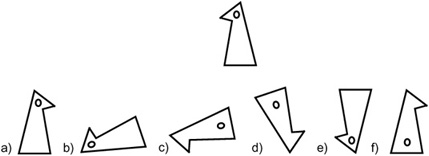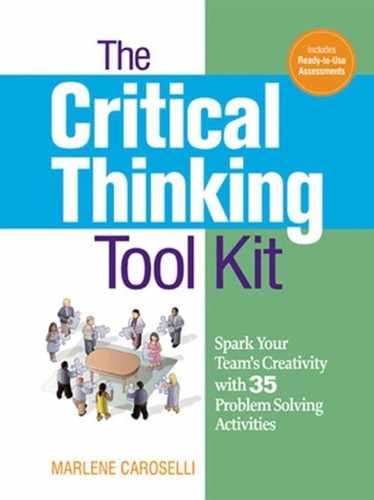#32: In Your Sights
Overview: |
Starting with a problem best solved by actually envisioning the situations, participants will proceed to contemplate a work-related problem in the same fashion. |
Objective: |
To foster imaginative reasoning. |
Supplies: |
A “back-up” problem—in case some class members have seen the original sock problem before. This will suffice: |
|
You have six matches and must form four equal-sided triangles from them. |
|
When you are tutoring the “imagine” group, encourage them to think in three dimensions, not two. If they can, they will have a flat triangle and in the space above it, three intersecting matches meeting to make three additional triangles. |
Time: |
Approximately 20 minutes |
Advance |
If possible, arrange for a breakout room so that half the class can work with you in solving a problem and the other half can leave the room to work on the same problem collectively or individually. |
Participants/ |
This exercise, suitable for any number of participants, works especially well as an ice-breaker, forcing communal effort and collegiality. It can also serve as a preview to the many times during the training to follow that participants will need to engage in this sort of reasoning as various issues are addressed. |
|
The exercise can also be used as a summarizing activity: have pairs imagine what it will be like when they return to their work sites. They can then formulate an action plan that will enable them to apply the learning they have acquired to the all-too-real circumstances awaiting them. |
Introduction to Concept:
Einstein as a child used to imagine himself chasing sunbeams through space. He often spoke of the importance of fantasizing. He regarded imagination, in fact, as being “more important than knowledge.” In more contemporary terms, management expert Tom Peters refers to imagination as “the only source of real value in the new economy.” In the following example, the answer will come more easily if you can actually imagine yourself performing the action.
You have just put a load of socks into the clothes dryer. There are 16 black socks and 10 brown socks inside the dryer. Without actually looking at what you are pulling out, how many socks will you have to take out of the dryer before you have a pair that matches?
1. Divide the class in half but assure participants that both teams are working on the same problem.
2. Gather one group around you and explain that you are not going to tell them the answer, but you are going to suggest that they try to find that answer by imaging themselves actually pulling socks out of the dryer, one at a time. How many socks would they need before finding a matched pair?
3. Review the answers with participants and encourage them to describe the process (if any) they used to solve the problem. Discuss how visualization could have helped (for example: You’ve bent over and pulled out a sock, but you cannot look at it. What color could it be? (Brown or Black.) Now you bend down and pull out another. What color is this one? (Brown or Black.) Pull out one more sock. What color is this? (Brown or Black.) What possibilities now exist with the three socks you have before you? (All three brown or all three black or two black and one brown or two brown and one black.) No matter the scenario, if you have three, you will have a matching pair.
4. Now divide the class into teams of four or five. Ask each team to select some change they are currently facing or would like to introduce (preferably work-related). Another option is for them to consider some danger or crisis situation in the workplace. Have them visualize, step-by-step, the events that could lead to various possible outcomes. Then have them retrace those steps, specifying how they would prepare for such crisis-possibilities.
5. Call on one person from each team to share the group’s imaginative reasoning.
Extending the Activity:
1. To develop spatial reasoning via visualization, prepare a number of exercises like this one:
What will this figure look like if it is rotated or turned over? Encourage visualization to find the answer.

The answer is b) (rotated) and if you wish to make it really difficult, the answer for turned over and upside-down is e).
2. The gift of fantasy, which Einstein also valued, can work for any of us. The fantasizing process would be as simple as imagining the perfect workplace, the perfect job, the perfect friendship, etc., specifying the elements that create the perfection, and then working to achieve some or all of them. Lead participants through such a process in relation to a situation that parallels one of the most serious discussions that arose during the training day.
Workplace Connections:
1. Encourage employees to continue their imaginative reasoning after the training is over. Using the buddy system, they can each prepare visual challenges like the first one in the extended activity. Then, on a daily basis, they can exchange their ten with those prepared by another employee. Depending on how many employees are involved, participants could have a whole month’s worth of challenges. Once all have been given and received, participants could prepare another ten and continue in the same way.
2. Recommend that participants read biographies of those they consider outstanding leaders and/or visionaries. Once a month, members of the informal group could have lunch together and discuss what they heave learned about calculation-via-conjecture.
Questions for Further Consideration:
1. What value can individuals derive from sharpening their imaginative reasoning abilities?
2. What major changes do you see in your future? What preparations are you making so the transitions between current and future states will be facilitated?
3. How much daydreaming do you do? Has it ever led to an improved state of affairs?
4. What can you do to improve your imaginative-reasoning abilities?
